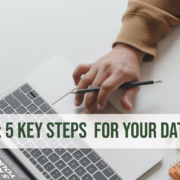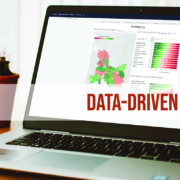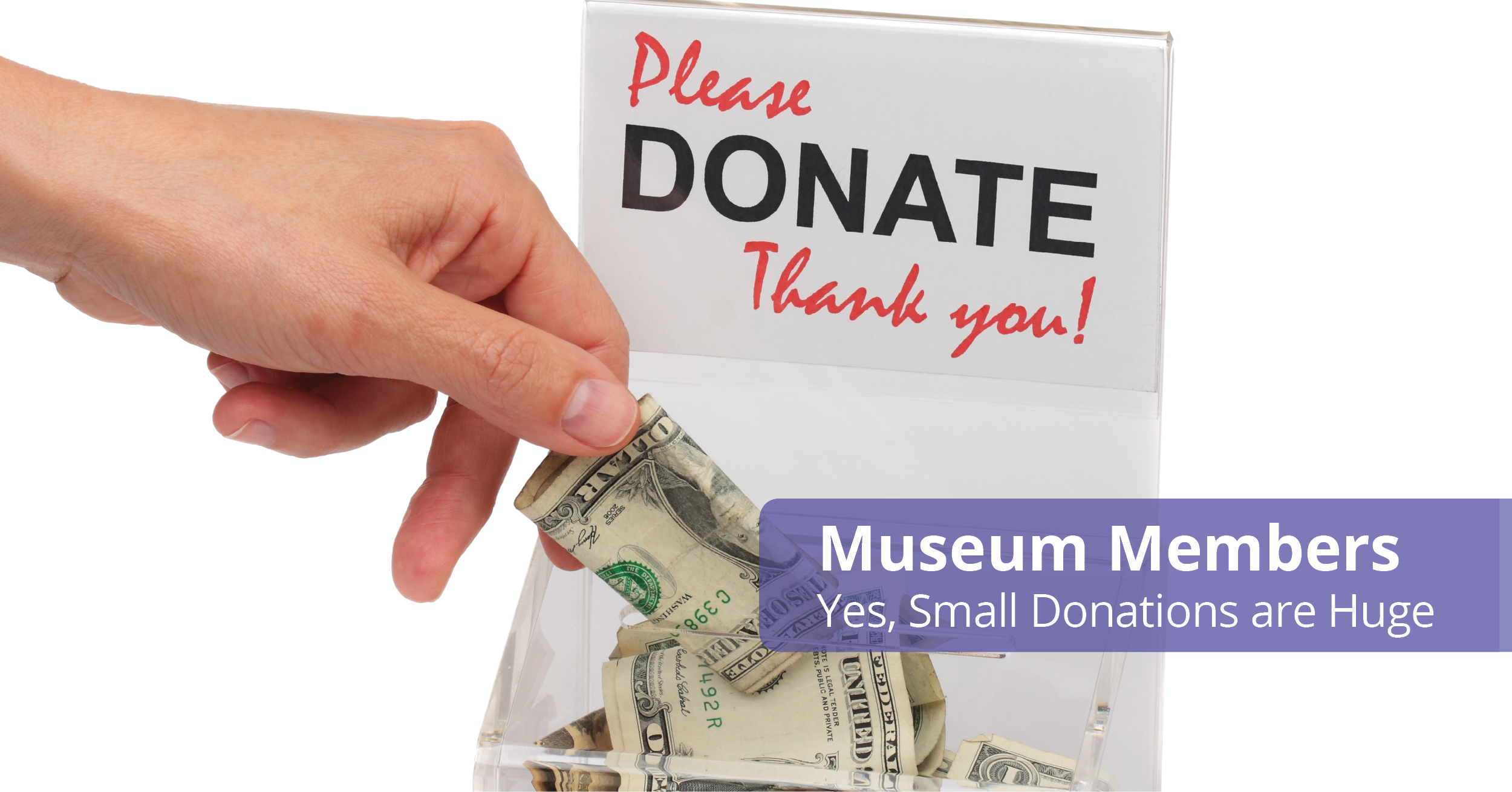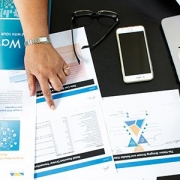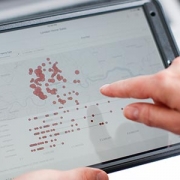Posts
Make Informed Business Decisions with Data-Driven Marketing
/in Customer Engagement, Insights /by Kaeleigh BeebeIn the uncertain times that have become our daily lives, it is more important now than ever to be smart about how best to communicate with your customers. Using Customer Insights effectively can provide a great value to marketers when activated through marketing and sales efforts to get the sales needle moving in the right direction. “Smart customer data” has emerged as a powerful strategic asset for the most successful marketing professionals. The process of using this data to help define goals, audiences, campaigns, and tactics-as well as measuring and analyzing performance- makes marketers much more agile and responsive to rapidly changing consumer expectations and behaviors. If you recognize the need to accelerate your marketing with a more data-driven, analytical approach, we recommend getting started with some of these ideas:
Assess when and how your customers want communication
- Give customers the opportunity to share their communications preferences with you by making it easy to do so on your privacy pages and in every reply form.
- Once they tell you their preferences, make sure you respond and respect their choices in your campaigns.
- Use message testing over multiple channels to build your understanding of what makes your customers tick and what types of messaging they respond to.
- Keep track of what worked and optimize results. The satisfaction of your customers could grow.
Use insights to drive your content strategy
- Different segments of your audiences will be interested in different types of content. Use insights about your segments in content development.
- Determine the types of marketing content and delivery formats your key segments crave and respond to the most.
- When developing different content, consider where customers are in the sales cycle. Are they gathering information and researching the category? Consider providing an overview of where you stand vs. your competition.
Master data-driven cross-selling
- Build a cross-sell matrix and keep track of the most likely next-to-buy products for your customers.
- Analyze the typical time between purchases, and make sure you trigger a cross- sell offer around the time your customers will be going back into the market.
Note: this cross-sell matrix should be based on real data and not just experience or a gut feeling.
Use customer data for digital micro-targeting
- Use digital ad buying platforms to deliver ads directly to your individual customers with segment specific messages.
- Push your current customer data into the platforms. They can build predictive models on the fly to find lookalikes.
- Deploy digital ads to the same group of people just before and just after direct mail contact to see if you can boost your direct mail results based on your call to action.
- Work with your media buying team to pilot some of these innovative 1:1 digital techniques and find out where you get the biggest bang return on investment.
Test offer-optimization
- Create offers with just enough incentive to get your customers and prospects to act.
- In addition to monetary offers, create offers that provide information or interesting content. Too many monetary offers can backfire and train your customers to wait for the best deal.
- Use a test and learn approach to get the most response from your product and service offering.
Whether your aim is to fine-tune marketing targeting by selecting audiences that will deliver the greatest return, to deliver more relevant messaging, or to find the customers that are ready to leave (or those that are ready to buy) – the answers are often found in your existing customer data. Analyzing data from inside your organization will build customer insights that can improve your marketing performance.
Respect the email: The power of email click-through rates and member renewals
/in Culture, Customer Engagement, Insights /by Kaeleigh BeebeNote: this is the third in a series of three blogs exploring member renewals for museums and nonprofits. You can read Part 1 and Part 2 on our Insights Blog.
We all know it: our members are our most invested and passionate audiences. They care about our mission, they know our exhibits and they love to bring friends. But sometimes, it’s a mystery on how to get new members to renew and become those die-hard super fans. How do we guide them along the path to becoming more engaged, supportive, active members of our community?
This week, we’ve been exploring this question using answers from a Member Renewal Model—a predictive tool that uses lifetime member data to identify the most important variables that affect renewal rates—we built for one of our museum clients earlier this year. They have a goal this year to improve first and second year member renewal rates and so we turned to the data to find some powerful, actionable insights on controllable variables for them to test.
Earlier this week, we explored the opportunity of soliciting small donations from members and the relationship between an onsite visit and a member’s expiration date. For our third and final insight, we turned to the world of email marketing to see how that impacts member renewals.
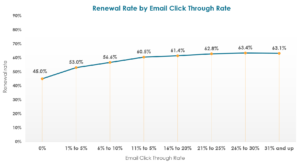
Member Renewal Insight #3: Members who click on their emails are more likely to renew
As a former museum email marketing manager, I can personally attest to the challenges of using such a strong communication channel in the best way possible. Between balancing various departments’ needs to promote programs or raise funds along with providing mission-based messaging and educational content to increase audience engagement, email is a perfect storm. Communicating the importance of this channel to museum leadership in an understandable way was important to me, and it’s my own personal goal to help others do the same for their institutions.
Knowing the power of this channel, we explored a wide array of email behaviors to make sure our renewal model truly tested the relationship between member email engagement and renewal as well. The findings give us some solid numbers: Members with a 0% click-through rate renew at 45% while members at the industry average click-through rate (between 25-31+% for most) have renewal rates over 62%.
More importantly, click through rates tell us how much folks are reacting to our emails and the general content as well. The strong relationship between good click through rates and renewal rates indicates a couple immediate actions for us to take: first, it underlines that our email focus needs to be on testing for the best email content – we need to ensure emails are written for the right audience, are engaging, and have the right pieces of content and not just all the content. Second, it gives us a clear KPI to focus on for engagement – click through rate not open rate – and a rationale for why that is our KPI. Finally, it underlines the value of an email to a member and gives a real statistic behind why the email marketing plan should be built on respect and audience-focused messaging.
Museum member renewal rates and visitation: get them in before they expire!
/in Culture, Customer Engagement, Insights /by Kaeleigh BeebeNote: this is the second in a series of three blogs exploring member renewals for museums and nonprofits. The first one explored the relationship between donations and renewals. Follow us on Facebook, Instagram, or Twitter for notifications when the last one comes out.
Earlier this week, we kicked off a mini-series exploring some key variables that affect member renewals for one of our clients, a history museum in Michigan, and the overall insights that speak to the nonprofit, museum, and cultural sectors on a whole.
We’ve been working with this museum for over 8 years to use data, analysis, and insights to better understand their members. This year, we have a clear goal: improve first and second year renewal rates. Not surprisingly, we turned to the data to find fact-based solutions and built a Member Renewal Model – a predictive tool that uses lifetime member data to identify the most important variables that we can control to positively change a member’s renewal rate.
While the model overall yielded a lot of really useful results, there were three really powerful variables that emerged that prove some key insights (and for those of us in the museum world, prove some long-rumored hypotheses!) that we can use various channels and tactics to try to control.
On Monday we explored the first insight, proving the power of small donations to member renewal. Today, we look at the relationship between visitation and renewing on time.
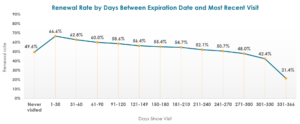
Member Renewal Insight #2: Members who visit within 90 days before their renewal date are more likely to renew
Or, to rephrase, the longer it’s been since a member has visited the museum, the less likely they are to renew. Let’s change that!
We investigated this relationship between renewal, visitation, and number of days before expiration date after reading Colleen Dilenschneider’s piece, Why Expired Members Do Not Renew Their Memberships. In short, she noted that one of the reasons lapsed members did not renew was that they planned to renew at their next visit. Which tells a larger story that the lapsed member never came in to visit and a larger action is needed to catch that slip in advance.
We decided to dig into this idea for our client and their members and found some important numbers to back this up on their end:
To start with the obvious, members who only visit near the start of their membership year renew at 21.4%. No one is probably surprised by this, but it’s always good when your data confirms assumptions.
More excitingly, there is a sweet spot in the data: a member who visits within the last 90 days before renewal sees a solid renewal rate between 60-67%. Within the last 30 days, we also know that front of house staff are trained to engage and remind members that their membership is about to expire to help accelerate any renewals right on the spot, but overall this tells us that a visit close to the membership expiration date really helps a member’s likelihood to renew.
We also checked overall frequency of visitation to see if we could find any other data trends that could help our goal to improve renewals. One other key point we found was: members who visit the institution three times in first five months have an average 67.5% renewal rate (a little higher than our group visiting 90 days before their expiration date). However, there are significantly more members (almost three times more) who visit in the last 90 days rather than those who visit three times in the first five months. If our overall goal is to identify actions that can improve the overall renewal rates for the most members, in terms on messaging, staff time, and member time it appears that driving a member to visit within the last 90 days before their renewal date will positively affect more people and ask less of everyone: it’s one ask (rather than three), it lets the museum team focus their messaging, and is the more likely behavior for more members.
Again, for those of us in the museum and cultural organizations sphere, it’s not too surprising that members who visit the museum are more likely to renew. They like you! Of course they’re going to come back! What this data does tell us is that there is a sweet spot and an opportunity to put it to use. It lets the museum focus visitation messaging on a smaller window to streamline communications, better segment their member base, and drive an overall better result from their members for all.
One last note: we can’t not mention the 49% renewal rate for a batch identified as “no visit.” The majority of this group are Year 3 and up members who are more invested in the museum overall. Since we’re focusing on raising the renewal rate for first and second year members, we wanted to look at actions and engagements that can help those groups.
Yes, small donations are huge for nonprofit member renewals
/2 Comments/in Culture, Customer Engagement, Insights /by Kaeleigh BeebeNote: this is the first in a series of three blogs exploring member renewals for museums and nonprofits. Follow us on Facebook, Instagram, or Twitter for notifications when the other two come out.
For the past 8 years, we have had the honor to work with a history museum in the Midwest with great audience goals and a robust membership program. In that time, we have used data, analysis, and insights to better understand their members and find the best ways to deliver audience-focused messaging to drive action and grow their relationship with this institution. From behavioral segments, to event engagement, to direct digital marketing, it has genuinely been some of our team’s favorite work.
Most recently, we’ve been tackling the goal to improve first and second year member renewal rates. We turned to data to help us find fact-based solutions to this challenge and we built a Member Renewal Model – a predictive tool that uses extensive member data to identify the key variables that we can control to improve their likelihood to renew.
As a former museum professional myself, there are plenty of hypotheses and trends in this sphere when it comes to improving membership engagement and renewal. What was so powerful about this model, however, is that we were able to prove some key factors that affect how members are renewing and put real data behind a plan to move forward.
This week I’ll be sharing three of those key variables, because they are essential to making a positive change, but also because they’re valuable enough that we hope other institutions might be able to put them to use too. Enjoy!
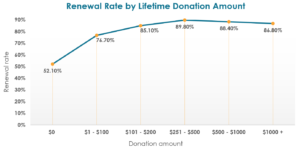
Member Renewal Insight #1: Members who donate even small amounts ($1-$100) are more likely to renew
It is not at all a surprising concept that members who support and donate to the museum, beyond the cost of their membership, are more likely to renew. For those of us in the nonprofit or cultural sectors, it’s why we focus giving campaigns and special events on members, as we know they’re just overall more likely to support the organization.
What was so powerful to prove for this institution, though, was the importance of small donations. When we turned to the data, we discovered a gigantic jump between members who donate $0 as compared to members who donate just $1 to $100. In short, we see a lift from a 52% renewal rate to a 77% renewal rate. That’s huge!
While small gifts might not make a huge difference to a museum’s overall budget over the course of a year, if it means that soliciting small gifts from members could improve renewal rates by 47%, those small gifts suddenly seem so much more powerful.
This ties in with the increasingly popular concept that folks become members at their preferred organizations primarily to support the organization (and not just for the access or financial benefits that come along with being a member). We’re in an era where an invested member understands the importance of their individual support and sees themselves as a part of the museum’s success, making those small gifts easier to attain and strengthen the relationship between member and organization.
“Smart” Data Can Help You Align Marketing and Sales
/in Insights /by Stefan WillimannSales and marketing team alignment is more important than ever! Our partner Hubspot reports that companies that get marketing and sales working together not only generate 208% more revenue from their marketing efforts – but they see 36% higher customer retention and 38% higher sales win rates.
Where does data fit into this alignment? Capitalizing on customer intelligence and making insights and clean data available to Sales can lead to a more efficient and effective process that can motivate and fire up your sales teams. Get started by using these analytical techniques:
Create Common Sales Cycle Definitions Across Marketing and Sales
Your sales team lives and dies on what they call leads, but Marketing might have a very different definition. Adopt a common language for each stage and definition of the sales cycle. Whether you use Prospects, Inquiries, Marketing Qualified Leads (MQLs), Sales Accepted Leads (SALs) and Sales Qualified Leads (SQL) or some other set of opportunity ratings, collaborate to define each stage across Sales and Marketing –so you can all start working towards the same goals, and be able to understand each other’s measurements.
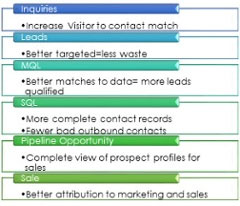
Here are some ideas for the metrics you might use:
Add a Score to Your Leads
Nothing will kill Marketing’s demand generation credibility faster than a bunch of unqualified leads being sent to the Sales team. Sales probably shouldn’t make a call until you know there is a budget and a timeline. Maybe lower cost sales channels like email or outbound telemarketing can be used to collect the missing data before a lead reaches an acceptable score. Alignment on the meaning of a “good lead” can really reduce friction and time to close.
Build a Common Definition of Your Segments – and Assign all Prospects and Customers

Building personas for web development won’t help the sales team much if they never see those types in the market place. Find real customer segments that purchase in distinct ways, and help the sales teams craft a USP for each segment that will give them a better shot at creating opportunities. Then, make sure each prospect and customer is assigned to a segment so sales can put that messaging to work on the ground.
Find Your Territory Gaps
Use your customer and prospect data to find the holes in territory maps where you have low coverage but high potential. You can often pull much more opportunity out of an area with better or more salespeople. Marketing often has the data to help make these decisions, but Sales is the team that needs to make decisions about coverage.
Use Purchase Likelihood Scores for Call Center Targeting
Outbound phone calls are not inexpensive and turnover in telesales can be high. Invest in reaching only the highest priority prospects by using predictive model scores in your call center. Focusing calling from the top down – best to worst prospects. This should cut the calls needed, improve team morale, and increase the success rate significantly.
Your marketing team should be able to add these types of smart data to customer and prospect records – and both Marketing and Sales can get aligned around your target and your critical asset – your data.
Creating Smart Data
/in Insights /by Stefan WillimannIf you and your team are spending time trying to wrangle all your various data feeds to find a way to create opportunities for your organization — there is a way to streamline your efforts. You don’t need to find a home for, and a way to use all your data — just the “smart data”.
The flow of data is picking up speed for all marketers, and astute leaders are turning this data into better, more targeted and relevant sales and marketing efforts. But managing all the data from web platforms, marketing technology, mobile devices and the “Internet of Things” is often a daunting and time-consuming task. Rather than focusing on managing the big data flow, we think marketers should try to discover the relatively few data points that can really drive revenue – find your smart data and put it to work!
Start with Customer Segments
The simplest way to begin data-driven messaging to customers and prospects is by understanding that different segments may purchase your products for different reasons or in different ways. For the B2C client we find that demographics or lifestyle factors drive differences in product usage, and for the B2B client – different industry verticals, or other firmographic data mean different likelihoods to buy products and services. Are you able to accurately identify these customer segments and analyze the differences in how they purchase or use your products and services?
Find Your Customers’ Trigger Point
Often times your customers will take some specific actions before they buy – or before they say good-bye (for example, checking their balance before paying off their car loan). These actions should be seen as prompts that can be used to trigger communications to make the sale happen faster, or keep a customer longer. Using predictive models can score your customers and prospects for their likely purchase propensity – but the model itself can identify the behavior triggers that can be turned into automated messaging programs.
Build an Engagement Score
Measure how engaged your customers are with your brand by creating a score that will combine interactions across channels (email, satisfaction, service calls or visits to the store). Keeping it simple with a High-Medium-Low engagement scoring process, you can easily tell if some customers just need more love!
Add “Data Transformations” to Your Data Clean Up
When you combine data from multiple sources you might receive basically the same fields from the different data sources – although they may have different names and slightly different values. For example, “current age” is not as easy to update as “year of birth,” and may actually be the most useful data element for use in marketing campaigns. Build common rules, definitions and data naming conventions so the data can be easily understood, and used efficiently in marketing, sales and operations. Data Transformations are key to making your data smart and actionable.
Trying to gain control of all the data generated by your marketing today can actually slow your progress to a more innovative data-driven approach. Quality over quantity is key! Find your top ten “Smart Data” elements, use them to test more relevant multi-channel efforts, and build in more variables as you grow.
5 Ways to Rev up your Marketing Performance with Data-Driven Fuel
/in Insights /by Stefan WillimannCustomer Insights give great value to marketers when they can be activated through marketing and sales efforts that move the sales needle in the right direction. “Smart customer data” has emerged as a powerful strategic asset for the most successful marketing professionals – and the process of using this data to help define goals, audiences, campaigns, and tactics as well as measuring and analyzing performance makes marketers much more agile and responsive to rapidly changing consumer expectations and behaviors. If you recognize the need to accelerate your marketing with a more data-driven, analytical approach we recommend getting started with some of these ideas:
1. Assess When and How Your Customers Want Communication
 Help customers let you know their communications preferences by making it easy on your privacy pages and in every reply form
Help customers let you know their communications preferences by making it easy on your privacy pages and in every reply form- Once they tell you their preferences – make sure you respond and respect their choices in your campaigns
- Use message testing to persuade your customers to interact with you over multiple channels to build your understanding of what makes them tick
- Keep track of what worked – optimize results and the satisfaction of your customers will grow
2. Use Insights to Drive Your Content Strategy
- Different segments of your audiences will be interested in different types of content. Use insights about your segments in content development
- Determine the types of marketing content and delivery format your key segments crave and respond to the most
- When developing different content, consider where customers are in the sales cycle – are they gathering information and researching the category? Give them an overview of where you stand vs. your competition
3. Master Data-Driven Cross-Selling
- Build a cross sell matrix and keep track of the most likely next-to-buy products for your customers
- Analyze the typical time between purchases, and make sure you trigger a cross sell offer around the time your customers will be going back into the market.
4. Use customer data for digital micro-targeting
- Use digital ad buying platforms to deliver ads directly to your individual customers – with segment specific messages
- Push your current customer data into the platforms. They can build predictive models on the fly to find lookalikes
- Drop digital ads to the same group of people just before and just after direct mail contact to see if you can boost your direct mail results
- Work with your media buying team to pilot some of these innovative 1:1 digital techniques and find out where you get the biggest bang
5. Test into Offer-Optimization
- Create offers with just enough incentive to get your customers and prospects to act
- In addition to monetary, create offers that provide information or interesting content. Too many monetary offers can backfire and train your customers to wait for the best deal
- Use a test and learn approach to get the most response from your product and service offering
Whether your aim is to fine-tune marketing targeting by selecting audiences that will deliver the greatest return, to deliver more relevant messaging, or to find the customers that are ready to leave (or those that are ready to buy) – the answers are often found in your existing customer data. Analyzing data from inside your organization will build customer insights that speed up your marketing performance.
5 Ways to Take Your Marketing Measurement to the Next Level
/in Insights /by Stefan WillimannSmart marketers have the luxury (and challenge!) of using more technologies and measurement tools than ever before, allowing us to project results and profitability, and look at customer and prospect behavior from different angles. While this should allow optimization like never before, campaigns are still often run “one-off,” with no more testing or optimization than before the MarTech boom. Habitually driven by short-term demands and the need to be responsive to quick changes in the markets, we often neglect to take the long view on marketing measurement to pursue long-term campaign improvement. If you’re looking to boost your performance, it’s important to take a look at what drives your ROI and how to effectively develop actionable insights and optimize your marketing performance over time.

A few strategies to consider:
1. Get Alignment on your most important measure of success
Find one or two key measures (e.g., new customers acquired, incremental revenue growth, retained customers, etc.) and make sure each of your marketing efforts are designed to drive results that can prove out success for those specific measures.
2. Create a measurement template for every campaign – and stick to it
Determine how results will be measured and create a measurement template that can be repeated in all your campaigns – how does the response work, who is responsible for measuring and reporting on it, how does the information get into a centralized format, what is the next interaction after the initial response, etc. The more you standardize measurement, the less you have to figure out in the heat of the battle.
3. Standardize Closed-Loop Campaign Measurement
Track your marketing efforts all the way to the sale with sophisticated databases and ecommerce platforms, loyalty programs and smarter data matching. Create a consistent measurement template so ongoing reporting will be easier and have the ability to become standardized. Rely on benchmarks to compare from campaign to campaign so you’ll be able to innovate more easily to boost results.
4. Create a Roadmap for Enhancing Your Marketing Measurement Methods
As you innovate and take advantage of new technologies (e.g. beacons) and/or new data sources (like machine data) your marketing measurement will also need to evolve over time. As you innovate, keep your focus on your key metrics for success. Plan to continuously enhance your measurement methods with the new data to determine the real impact of those innovations. Don’t forget to budget for updates to your database and the design of new measurement methods.
5. Create a Three Year Learning Plan
Often a “point-in-time” campaign analysis misses the big picture. Effectively monitor and evaluate the impact of your efforts over time by setting learning goals that can be tested and proved out over multiple waves of your initiatives. Build long term testing into every effort to keep trying to beat the benchmarks for your most key measures of success.
If you’re under pressure to improve marketing results, these five best practices can improve your operations and drive to optimize. We invite you to take the next step to change your marketing processes to get to repeatable improvements in your marketing ROI.
Build Your Data Strategies
/in Insights /by Stefan WillimannVirtually everything we do produces more data, and it’s a fact that marketers who can capitalize on that data are the winners in their respective industries. Data Equity (the value of your company’s data) has begun to pop up as an asset on corporate balance sheets, and it’s imperative for you to be armed with real-time, actionable analytics and business intelligence to drive smarter marketing, sales and business decisions. Data views need to be easy to understand and customize, when and where you need it.
 SIGMA has spent over 30 years helping our clients capture the hidden value in their data contributing to customer acquisition, sales force optimization, and consumer loyalty. We are poised to share strategies that we know will continue to help you engage and grow your customers – and your client’s customers.
SIGMA has spent over 30 years helping our clients capture the hidden value in their data contributing to customer acquisition, sales force optimization, and consumer loyalty. We are poised to share strategies that we know will continue to help you engage and grow your customers – and your client’s customers.
We’ve engaged our SIGMA thought leaders and curated some insightful and interesting content that will help you consider how to build out your data strategies for the rest of 2018 and beyond. We invite you to join our mailing list so we can share these, and other, very important insights:
- 5 Ways to Take Your Marketing Measurement to the Next Level
- B2B Data 101 eBook
- 100 Ways eBook
- Successful analytics eBook
- Data Driven Success eBook
If there is something you would like to learn more about, please leave a comment below. As always, we are here to help.
SIGMA Data Insights
Subscribe
Stay up to date with insights in your inbox.

